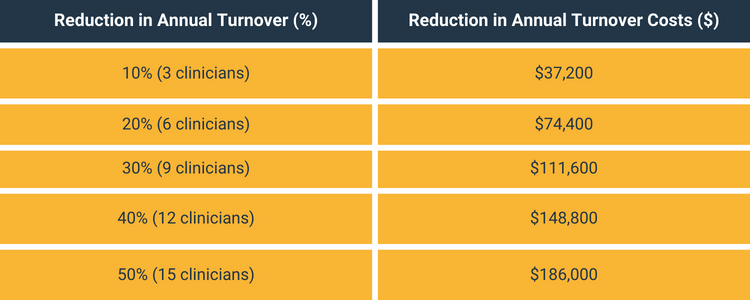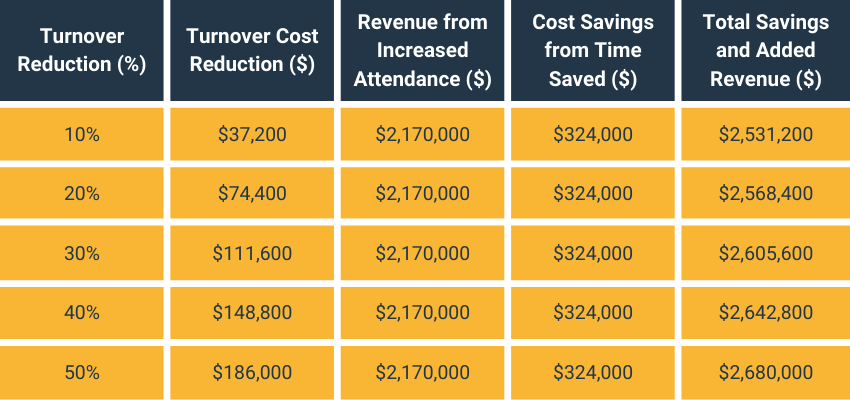Running a successful behavioral health organization is no easy feat. Margins are thin, budgets are stretched, and there’s zero room for financial error. One poor investment could have major ramifications for the quality and accessibility of behavioral health services in your community.
It’s always exciting to talk about the bells and whistles of any innovative healthcare solution—behavioral health AI included—but at the end of the day, the juice has to be worth the squeeze. In other words, you need to know that the technology you choose to implement will yield a real, measurable return on investment (ROI).
In behavioral health, every dollar counts—and knowing exactly how each solution in your tech stack will ramp up revenue and tamp down costs is the only way to ensure you’re making sustainable choices that will ultimately benefit those who rely on your care.
On that note, we’ve put together the following analysis to demonstrate the impact of Eleos Health’s CareOps Automation platform on your organization’s top and bottom lines. Read on to discover how Eleos can make a quantifiable difference by way of:
- staff turnover reduction,
- enhanced compliance and claims,
- higher patient attendance, and
- administrative time savings.
ROI Factor #1: Reduced Turnover
Turnover Cost Per Employee
Turnover is a costly affair. And with the pressure to retain staff greater than ever—especially in light of staffing requirements tied to new care models like Certified Community Behavioral Health Clinics (CCBHCs)—it’s a cost behavioral health organizations want to avoid at, well, all costs. And even though turnover may in some cases be inevitable, lengthening the tenure of each employee still helps curb the overall financial impact of staff departures.
Conservative estimates put the cost of turnover for one employee at roughly one-fifth of that employee’s salary. So, if a clinician has an annual salary of $60,000, the cost of losing that employee—including the loss of their productivity, the drain on remaining team members’ productivity, and any expenses associated with recruiting and training their replacement—is about $12,000. That’s a significant chunk of change, especially multiplied across several vacancies.
Total Annual Cost of Turnover
Assuming an average annual turnover rate of 31.3% in behavioral health, a facility that employs 100 clinicians can expect approximately 31 of them to leave the organization each year. Multiply those exits by the $12,000 cost per individual turnover, and the annual financial toll comes in at a staggering $372,000.
And keep in mind that turnover rates can be much higher in settings like community mental health, where new providers often go to amass work experience before leaving for greener pastures. So, retention efforts are especially important for that particular segment of the workforce.
Potential Savings with Reduced Turnover Rates
Here’s how reduced turnover directly impacts your bottom line (again, assuming 100 total staff clinicians):

Eleos has been shown to meaningfully impact major turnover factors like daily stress levels. In fact, 90% of providers at Trilogy who were given access to Eleos reported feeling less job-related stress—and nearly 8 in 10 of those providers said Eleos would positively impact their tenure in their current position.
That’s pretty powerful considering that even a 10% decrease in turnover translates to $37,200 in annual cost savings. Bumping that reduction to 30% gets you into six-figure territory—at which point you can start to reallocate those funds in truly meaningful ways, whether that’s through upgrading your technology, investing in additional staff training and development, or improving/expanding your facility.
ROI Factor #2: Enhanced Compliance
Compliance issues can be an insidious drain on your organization’s financial health. Claim denials, corrective action plans (CAPs), and take-backs due to billing errors, documentation discrepancies, or failure to meet regulatory guidelines are a pervasive pain across all of healthcare—but they are particularly burdensome in behavioral health due to the complex and sensitive nature of the services provided.
In fact, an audit report released in 2023 by the Office of the Inspector General (OIG) revealed that between March 2020 and February 2021, over half of the $1 billion Medicare paid for psychotherapy services was “improper.”
Compliant Documentation
Though it’s challenging to quantify the exact cost savings tied to improved documentation and claims, suffice is to say that by minimizing errors, you can substantially decrease the risk of having funds recouped. Plus, accurately capturing the full scope of services provided helps ensure maximum payment.
That’s where tools like Eleos come in: our system automatically generates compliant, defensible, clinically relevant note suggestions based on the full content of each unique session. While providers are experts at delivering amazing care, they aren’t always able to clearly capture that value in the note. Our AI models are primed to translate their work into words that auditors and payers can easily understand—and that meet their requirements for payment.
In fact, through several internal before-and-after studies involving thousands of Eleos-generated notes, our data scientists have pinpointed a variety of compliance factors our system positively impacts. (Note that these stats are tied to individual Eleos customers, as we have not yet conducted a comprehensive compliance analysis across all customers.) These findings include:
- 70% reduction in note redundancy compared to notes produced prior to implementing Eleos.
- 42% increase in compliant plan notes after implementing Eleos.
- 118% increase in the number of therapeutic interventions mentioned in notes after implementing Eleos.
- Nearly 2x increase in the number of progress-related words and phrases used in notes post-Eleos implementation.
Improved Operations
Tightening up documentation and billing compliance isn’t just about optimizing your revenue cycle; it has downstream implications for your entire organization. Fewer clawbacks and higher payments mean more available funds—which can be invested back into patient care and staff development. Better documentation is not just a financial advantage, but also an operational one—creating a domino effect of benefits to client progress and care continuity.
ROI Factor #3: Fewer No-Shows
No-shows are a harsh reality in mental health settings, sometimes reaching rates as high as 60%. For the purposes of this analysis, we’ll use a more conservative estimate of a 35% no-show rate.
The High Cost of Missed Appointments
Let’s continue with our example facility that employs 100 clinicians. Assuming each clinician provides 5 sessions a day, 5 days a week, over 50 weeks—that’s 1,250 sessions per clinician annually.
With a 35% no-show rate, each clinician would experience about 438 missed sessions per year.
Multiply that by a conservative payment estimate of $74 per session, and the annual revenue loss from no-shows comes to $32,375 per clinician. For a facility with 100 clinicians, this skyrockets to a staggering $3,237,500 a year.
The Eleos Effect on No-Show Rates
Therapists using Eleos saw a 67% increase in patient attendance, thanks in part to their ability to better focus on, and engage with, each individual—as well as leverage detailed clinical insights to deliver better care and achieve better results. So, if our hypothetical clinic started using Eleos, they theoretically would see their no-show rate plummet to about 12%.
That means each clinician would lose only 144 sessions annually, equating to an annual revenue loss of $10,684 per clinician.
Recaptured Annual Revenue
Following the math, the use of Eleos recaptures $21,691 of revenue per clinician ($32,375 original loss – $10,684 loss with Eleos).
For a facility employing 100 clinicians, the total annual recaptured revenue amounts to a substantial $2,169,125.
So, while no-shows are a ubiquitous issue in behavioral health, the right tools can make a huge difference—in terms of both improving your bottom line and ensuring more consistent, efficient, and effective care for your clients.
ROI Factor #4: Time Savings
As the old saying goes, time is money. But in behavioral healthcare, the value of time isn’t defined solely by the number of patients seen or sessions held. By streamlining providers’ administrative workflow, Eleos enables them to focus more intently on each client—and themselves. And that leads to better job satisfaction and enhanced client care.
Documentation Time Savings
Eleos significantly reduces the amount of time it takes to document a session. For example, Gaudenzia, Inc., was able to reduce documentation time from 10 minutes per session to about 4.8 minutes per session—a savings of 5.2 minutes.
For a provider who conducts 5 sessions per day, 5 days per week, 50 weeks per year, the cumulative time saved with Eleos would amount to 6,500 minutes—or about 108 hours—per year. That’s more than 2.5 weeks of full-time work!
Dollar Value of Time Saved
The average annual salary for a mental health clinician is $60,000, which breaks down to approximately $30 per hour. Assuming that Eleos saves each individual clinician 108 hours of work each year, the dollar value of that time savings comes to about $3,240 per clinician. For an organization employing 100 clinicians, that’s a total annual savings of $324,000.
And remember, the impact of that time savings isn’t limited to additional clients or sessions. It also opens up time for more provider training, education, and mentorship; more padding between appointments for employee self-care; or even new opportunities for community involvement. The possibilities—and potential for additional ROI realization, both directly and indirectly—are endless.
Total Savings Visualized: The Cumulative Impact Per 100 Clinicians
The impact of just one of the ROI factors covered above might be enough to convince you that Eleos is worth a closer look. But to appreciate the full value of this technology, one must also consider its benefits more holistically.
Here’s a quick overview of what that value looks like per year. Even at the low end of these scenarios, Eleos pays for itself several times over.
Annual ROI with Eleos*

* Based on an organization employing 100 full-time behavioral health clinicians. Dollar amounts associated with attendance and time savings are fixed for the purposes of this analysis.
The numbers don’t lie—and these calculations are based on conservative estimates. The actual impact to your organization could be much greater.
But looking at this analysis, one thing is clear: behavioral health organizations can’t afford not to have a solution like Eleos in their toolkit. It’s only a matter of time before Augmented Intelligence becomes not just a nice-to-have, but a must-have for organizations that want to stay financially and operationally viable—not to mention, compete for top provider talent.
Curious about your Eleos ROI?
Use the ROI calculator below to determine the dollar value of Eleos to your behavioral health organization.
Margins are tight and stakes are high; that’s the reality in behavioral health. While some may see the integration of new technology as a risk, it’s hard to argue against cold, hard ROI numbers. With measurable financial benefits like these, the decision to take the AI plunge becomes a no-brainer.
But the real endgame here isn’t just better financials; it’s elevated quality of care. The impact of supporting your staff and creating a positive care experience can’t be quantified as line items in a budget; these are foundational elements for any reputable behavioral health organization. Eleos frees up resources that you can invest back into your clinicians and, by extension, your clients—and no ROI formula in the world can calculate the benefit of that.